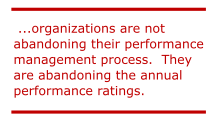
Performance Appraisal: Getting to the Heart of the Problem
Several organizations have done away with performance ratings, and others have made a steadfast commitment to this practice. For those reconsidering their approach – should one scrap performance ratings or work to improve the process? Perhaps the more important question is -are performance appraisals the real problem or is it something else? We spoke with Dr. Jim Smither, a well-known authority on Performance management. Dr. Smither’s research has appeared in top-tier peer-reviewed journals. He is also a highly regarded advisor and consultant to corporations and not-for-profit organizations. This blog post has excerpts of our conversation with Dr. Smither on this controversial topic.
SSB: What’s your reaction to organizations like Adobe and Kelly Services abandoning their performance management processes?


SSB: While many organizations are moving away from the rank and yank process (e.g., Microsoft) there are new adopters like Yahoo. Are there better ways of addressing poor performers
JS: I don’t know anybody who likes the rank and yank process. Here’s what happens when you tell people “you have to have someone at the bottom category at the end of the year and we will probably move that person out of the business.” They deliberately keep the weak performers around until the end of the appraisal period, so they have somebody to put in that box. What they ought to do is move the person out of business much earlier. Rank and yank encourages a lot of game playing and creates a lot of dysfunction.
SSB: Given the inherent problems with the rating process, are we ignoring human tendencies that make such ratings flawed? Studies show that we humans are not perfect, rational decision-makers and our decisions tend to be influenced by all kinds of biases. Are we asking managers to do something that they are not humanly capable of doing?
JS: Of course my answer to that is yes. But everything that managers do is subject to biases, and memory and processing shortcomings, and judgmental problems. It’s not unique to just the performance appraisal process.
SSB: That’s probably the heart of the problem. Any other replacement to the current system is likely to be equally flawed as long as manager judgments are involved. This is probably a great place to implement big-data solutions in HR. If we had more objective data about performance collected over a period, it would lead to more accurate ratings instead of managers relying on their memory.
JS: I think that’s a noble idea, but I don’t think it’s going to solve the problem. First of all, we got to make better use of data. Nobody is going to argue about that. But for many aspects of work performance, no objective data are available. Even when we have objective data, that data tends to be deficient or contaminated. Plus when people figure out the metrics, they try to drive their performance based on the data being captured. That creates a whole bunch of distortions. Another option is to get more opinions from many people. I applaud that idea but that data is also flawed and subject to the same kind of systematic biases.
SSB: Given all the challenges we’ve talked about, is there a way to have objective and fair appraisals?

High-performing organizations realize that the key thing is realizing what’s happening day in and day out. It’s the informal conversations and ongoing feedback that are important. We know when you recognize people for doing good work they do more of it.
Studies show that when we set challenging goals and people accept those goals, and we give them feedback along the way, and we praise them when they attain those goals- those things engage people, and we get higher levels of performance. These are the things we should be focusing on. These are very well-established psychological principles that have been around for a very long time.

Hopefully, this provides greater clarity on the issue. See the seven-part list summarizing the guidance. The biggest challenge is not with performance ratings (although there’s room to make them more accurate), it’s the missing focus on the ongoing development and keeping employees motivated. Dr. Smither also talked about the importance of trust and justice to get the full benefit of performance management. There’s plenty of well-researched evidence-based guidance available on this topic. We cover these and provide a comprehensive guide in our course on Performance Management. Follow this link to learn more
Dr. Jim Smither is the Chair and Professor of Management and Leadership at La Salle University. Previously, Jim was a Senior Manager/Group Leader in corporate human resources for AT&T where he was responsible for developing and validating employee selection programs for management-level positions. He is currently a Consulting Editor at the Journal of Applied Psychology. He has edited two books (published by Jossey-Bass) that present research/evidence-based best practices in performance management. He has consulted with over 55 firms in human resources and leadership development.
Seven practices to boost the power of your performance management process
- Focus on performance management and not performance appraisal.
- Make it an on-going process and not an annual event.
- Use annual ratings only if you have a competitive, reward-based culture.
- Use multiple raters and objective data to increase the accuracy of the annual ratings. However, don’t expect them to be perfect.
- Set goals that employees accept and provide on-going feedback.
- Recognize and praise good performance and do it often.
- Focus on improving trust and perceived justice between employees, their managers, and the organization.

